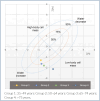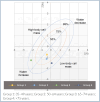Prevalence of low-body cell mass evaluated by bioelectrical impedance vector analysis related to aging
- PMID: 39536239
- PMCID: PMC11554316
- DOI: 10.1590/1806-9282.20240088
Prevalence of low-body cell mass evaluated by bioelectrical impedance vector analysis related to aging
Abstract
Objective: The objective of this study was to determine the prevalence of low-body cell mass by sex and age in a community-dwelling population.
Methods: In this retrospective study, 981 community-dwelling adults aged ≥35 years (648 women and 333 men) from Mexico City were recruited in a subway station between February and April 2012. Demographic data, anthropometry, and body composition were assessed, and self-reported comorbidities were recorded in the consulting room. Impedance values were obtained using mono-frequency equipment at 50 kHz. For the diagnosis of low-body cell mass by bioelectrical impedance vectorial analysis: resistance (R, Ohm) and reactance (Xc, Ohm) values were adjusted for height to obtain impedance vector (R/H and Xc/H) and then plotted in the R/Xc to perform the bioelectrical impedance vectorial analysis RXc Z-score analysis.
Results: The total prevalence of low body cell mass by bioelectrical impedance vectorial analysis was 29.4% (n=288) with a 95%CI 26.5-32.3%; was higher in men (39%) compared with women (24.4%) (p<0.0001). The group aged>75 years had the highest prevalence (men: 85.3%, p<0.001; women: 63.3%, p<0.001). The bioelectrical impedance vectorial analysis RXc Z-score analysis showed lower cell mass in men aged>75 years (R Z-score -0.30, Xc Z-score -2.13), and women aged 65-74 years also presented with overhydration (Z-score -2.6, Z-score -1.27).
Conclusion: The prevalence of low body cell mass, evaluated by bioelectrical impedance vectorial analysis, increased with age. RXc Z-score analysis could be a useful tool to evaluate nutritional status and changes in hydration in community-dwelling populations.
Conflict of interest statement
Figures
Similar articles
-
The implications of bioelectrical impedance vector analysis in older adults with hip fractures.Maturitas. 2025 Mar;194:108209. doi: 10.1016/j.maturitas.2025.108209. Epub 2025 Jan 28. Maturitas. 2025. PMID: 39892122
-
Specific bioelectrical impedance vector reference values for assessing body composition in the Italian elderly.Exp Gerontol. 2014 Feb;50:52-6. doi: 10.1016/j.exger.2013.11.016. Epub 2013 Dec 3. Exp Gerontol. 2014. PMID: 24316033
-
Bioelectrical impedance vector analysis in obese women before and after bariatric surgery: changes in body composition.Nutrition. 2014 May;30(5):569-74. doi: 10.1016/j.nut.2013.10.013. Epub 2013 Oct 31. Nutrition. 2014. PMID: 24698348
-
Bioelectrical impedance vector analysis (BIVA) as a method to compare body composition differences according to cancer stage and type.Clin Nutr ESPEN. 2019 Apr;30:59-66. doi: 10.1016/j.clnesp.2019.02.006. Epub 2019 Mar 1. Clin Nutr ESPEN. 2019. PMID: 30904230 Review.
-
Bioelectrical impedance analysis in clinical practice: a new perspective on its use beyond body composition equations.Curr Opin Clin Nutr Metab Care. 2005 May;8(3):311-7. doi: 10.1097/01.mco.0000165011.69943.39. Curr Opin Clin Nutr Metab Care. 2005. PMID: 15809535 Review.
References
-
- Rondanelli M, Talluri J, Peroni G, Donelli C, Guerriero F, Ferrini K, et al. Beyond body mass index. Is the body cell mass index (BCMI) a useful prognostic factor to describe nutritional, inflammation and muscle mass status in hospitalized elderly?: body cell mass index links in elderly. Clin Nutr. 2018;37(3):934–939. doi: 10.1016/j.clnu.2017.03.021. - DOI - PubMed
MeSH terms
LinkOut - more resources
Full Text Sources
Miscellaneous



